Key takeaways
- Flutter’s hot reload feature significantly enhances development efficiency by allowing instant preview of code changes.
- The rich library of widgets enables developers to create highly customizable and visually appealing user interfaces.
- Engagement with the vibrant Flutter community provides valuable support and resources for overcoming challenges.
- Prioritizing user experience through intuitive design and thorough testing is crucial for app success.
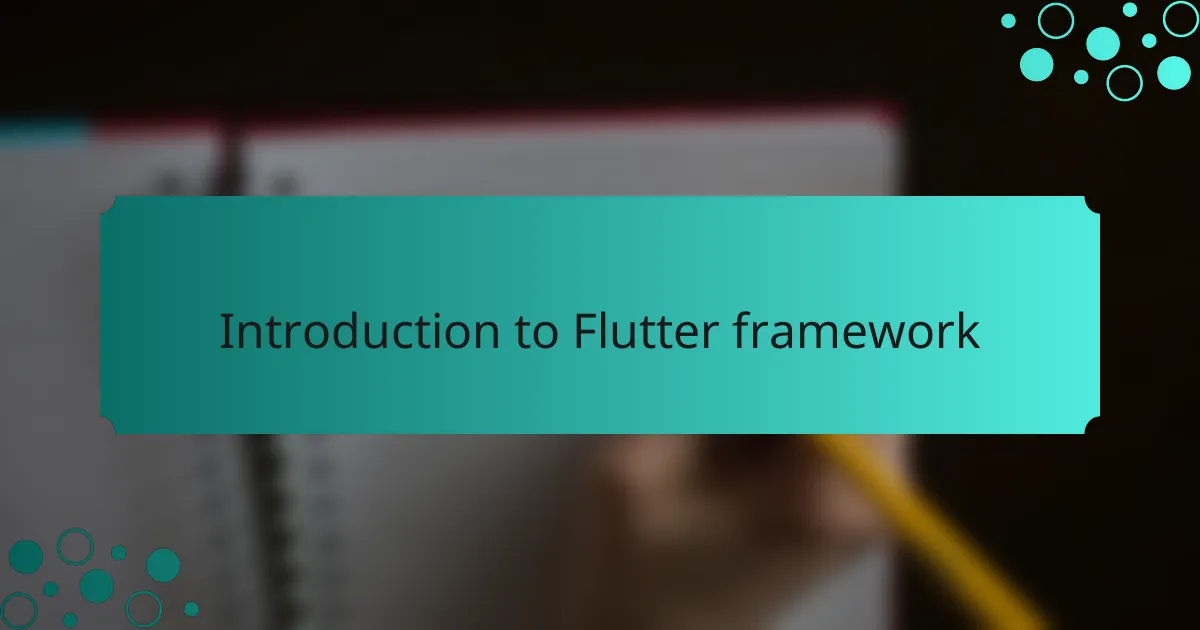
Introduction to Flutter framework
When I first heard about Flutter, I was intrigued by its promise of building beautiful, natively compiled applications from a single codebase. Imagine writing your app once and running it seamlessly on both iOS and Android—that’s a dream for many developers! The excitement of exploring a new framework, especially one that seemed to simplify the app-building process, was palpable.
What truly struck me about Flutter is its use of the Dart programming language, which, while not as widely known as some others, has a certain elegance. As I dove into Dart, I appreciated its clear syntax and efficient performance, making it easier to grasp than I initially expected. I often ask myself, isn’t it motivating to learn a language that feels like it has been designed with developer experience in mind?
Additionally, the wealth of pre-built widgets in Flutter made the design phase incredibly enjoyable for me. I remember spending hours experimenting with different UI elements and animations, feeling almost like an artist painting a masterpiece. It raises a question that many new developers might ponder: Can a framework really make app development as fulfilling as creating art? In my experience, Flutter does just that.
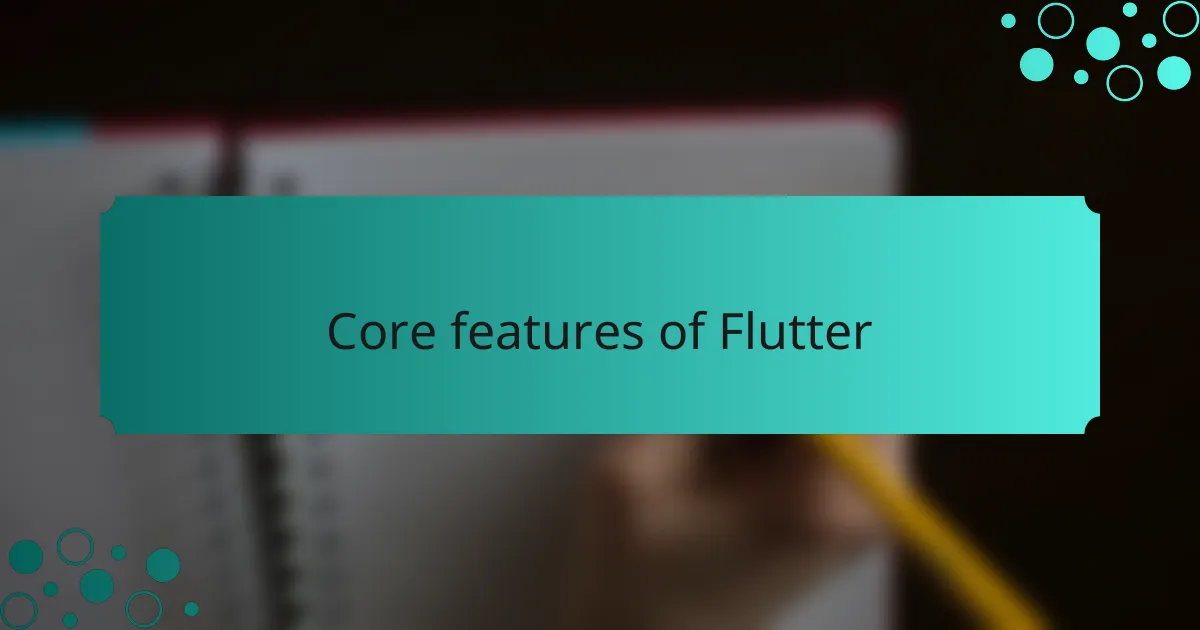
Core features of Flutter
When I first dove into building apps with Flutter, I was immediately struck by its hot reload feature. It felt like magic to make changes to my code and see them reflected on the screen almost instantly. This feature not only sped up my development process but also kept me energized and engaged, as I could iterate quickly and fine-tune my designs without the tedious recompilation time.
Another standout aspect of Flutter for me is its widget-centric architecture. Each element in a Flutter application is a widget, providing a flexible and customizable approach to building UIs. This really speaks to my creative side; I can compose complex UIs simply by nesting widgets. The feeling of crafting something unique and responsive to users was one of the most rewarding experiences of my programming journey.
Key features of Flutter include:
– Hot Reload: Instant preview of changes allows for rapid prototyping.
– Rich Widget Library: A plethora of pre-designed widgets for seamless UI integration.
– Cross-Platform Development: Write one codebase for both iOS and Android.
– High Performance: Compiled to native ARM code for smooth animations and overall performance.
– Dart Language: Easy to learn with a clean syntax, perfect for both beginners and experienced developers.
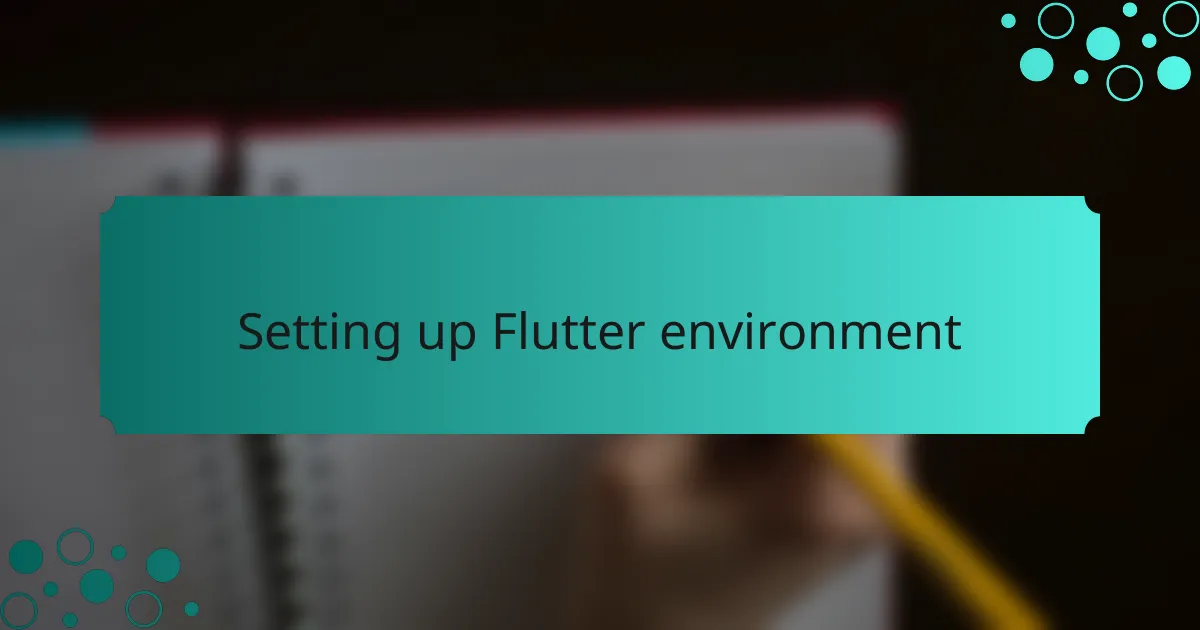
Setting up Flutter environment
When I first set up my Flutter environment, I anticipated significant challenges. To my surprise, the installation was quite smooth. I followed the official documentation, and the step-by-step guidance really made a difference. It felt rewarding to see everything come together quickly, allowing me to dive straight into building my first app.
Comparing Flutter with other frameworks, it’s clear why developers enjoy using it. The unified codebase for both iOS and Android saves time, and the hot reload feature is nothing short of magical. Instantly seeing changes without losing the app’s state is a game-changer for productivity.
“`html
| Feature | Flutter | React Native |
|---|---|---|
| Platform Support | iOS & Android | iOS & Android |
| Hot Reload | Yes | No |
| Performance | High (native) | Medium (bridge) |
| Learning Curve | Moderate | Steep |
“`
Through my experience, I found Flutter to be both accessible for beginners and powerful enough for seasoned developers. It truly creates a delightful workspace to bring ideas to life.
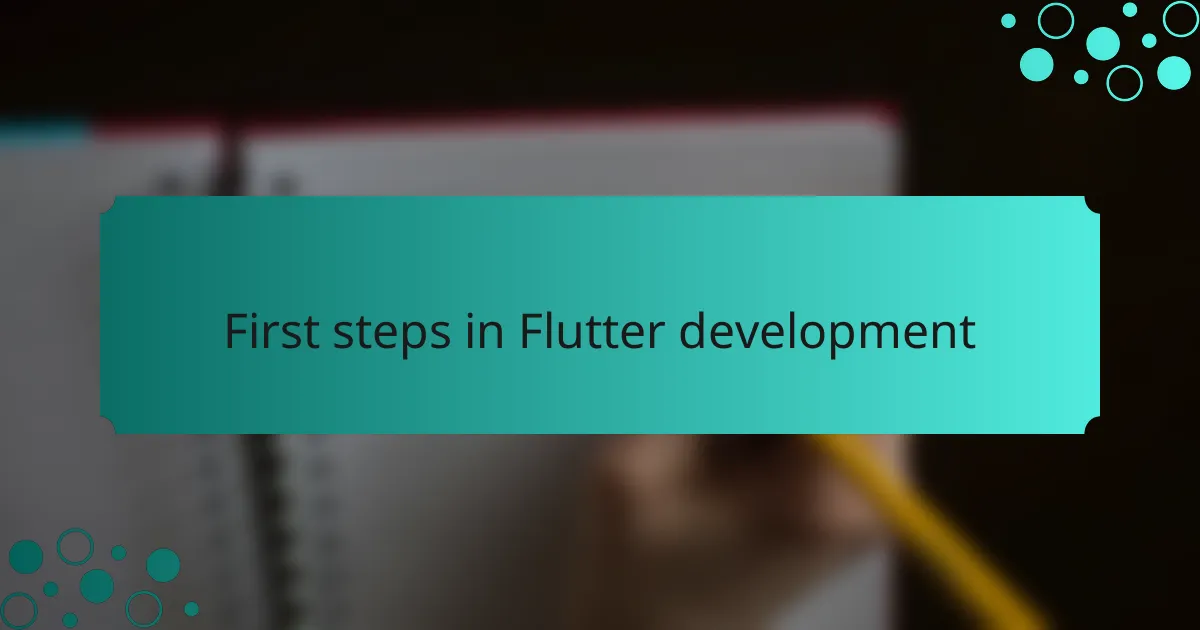
First steps in Flutter development
When I first delved into Flutter development, I was captivated by its ability to create beautiful applications with a single codebase. The initial setup was surprisingly straightforward, and I remember the thrill of quickly building my first widget. It felt empowering to see my code come to life on both iOS and Android devices without making significant adjustments for each platform.
As I explored Flutter further, I encountered various tools and libraries that made the journey much smoother. Using packages like ‘http’ for networking and ‘provider’ for state management helped me feel more confident in structuring my applications. I still recall the satisfaction of overcoming my first major bug; debugging in Flutter can be challenging, but it taught me resilience and boosted my problem-solving skills.
Here’s a comparison of Flutter and some other popular frameworks based on my experience:
| Feature | Flutter | React Native | Native Development |
|---|---|---|---|
| Development Speed | Fast, Hot Reload | Moderate | Slow |
| Performance | High, Native-like | Good | Excellent |
| Learning Curve | Easy for Dart users | Moderate | Steep |
| UI Flexibility | Highly Customizable | Moderate | High |
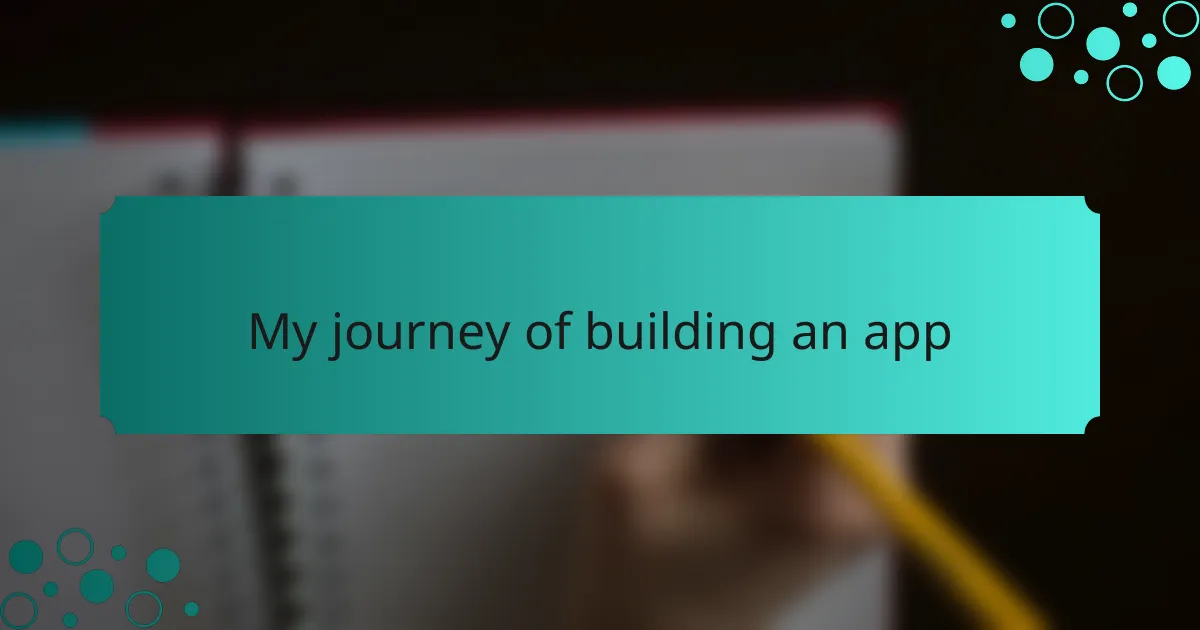
My journey of building an app
Diving into the world of Flutter was nothing short of exhilarating for me. I remember my first attempt at building an app; the excitement pulsated through me as I watched my lines of code materialize into a functional interface. The instant feedback from Flutter’s hot reload feature allowed me to tweak things in real-time, which made each small victory feel even more significant.
As I navigated through challenges, such as learning Dart (the programming language used by Flutter), I often found myself frustrated but ultimately inspired by the possibilities ahead. With each completed feature, I felt a sense of pride, knowing that I was building something from the ground up. Here are some key takeaways from my journey:
- Initial Learning Curve: Adapting to Dart’s syntax took some time, but it became easier with each line of code.
- Community Support: Engaging with forums and other developers provided invaluable resources and encouragement.
- Real-time Feedback: Flutter’s hot reload feature was a game-changer, making the development process much more interactive.
- Project Iteration: Constantly refining my app based on user feedback made the final product more user-friendly and polished.
- Sense of Accomplishment: Completing my first app ignited a passion for mobile development that I continue to explore.
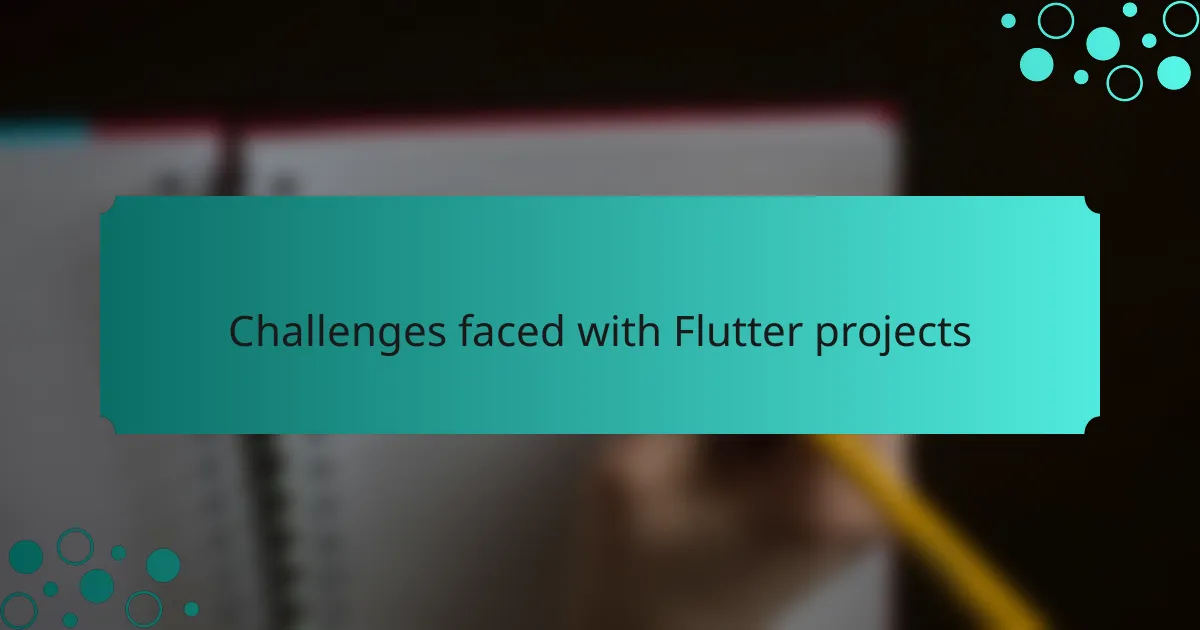
Challenges faced with Flutter projects
When I first started working on Flutter projects, I was excited about its promise of a unified codebase for both iOS and Android. However, I quickly encountered challenges. One of the most frustrating was dealing with the limited third-party libraries compared to more established frameworks. There were moments when I found myself creating workarounds for functionality that I expected to find readily available, which was both time-consuming and a bit demoralizing.
Another significant hurdle I faced involved debugging. Flutter’s hot reload feature is fantastic, but when things went wrong, tracking down the source of an issue felt like searching for a needle in a haystack sometimes. I vividly remember spending hours trying to figure out why a widget wasn’t displaying correctly, only to discover it was a small typo. These challenges, while sometimes overwhelming, ultimately pushed me to deepen my understanding of the framework.
Here’s a quick list of challenges I encountered during my Flutter projects:
- Limited third-party libraries compared to native frameworks.
- Debugging complexities that can arise unexpectedly.
- Platform-specific issues that require additional attention.
- Learning curve associated with Dart, Flutter’s programming language.
- Initial setup of the development environment can be tricky.
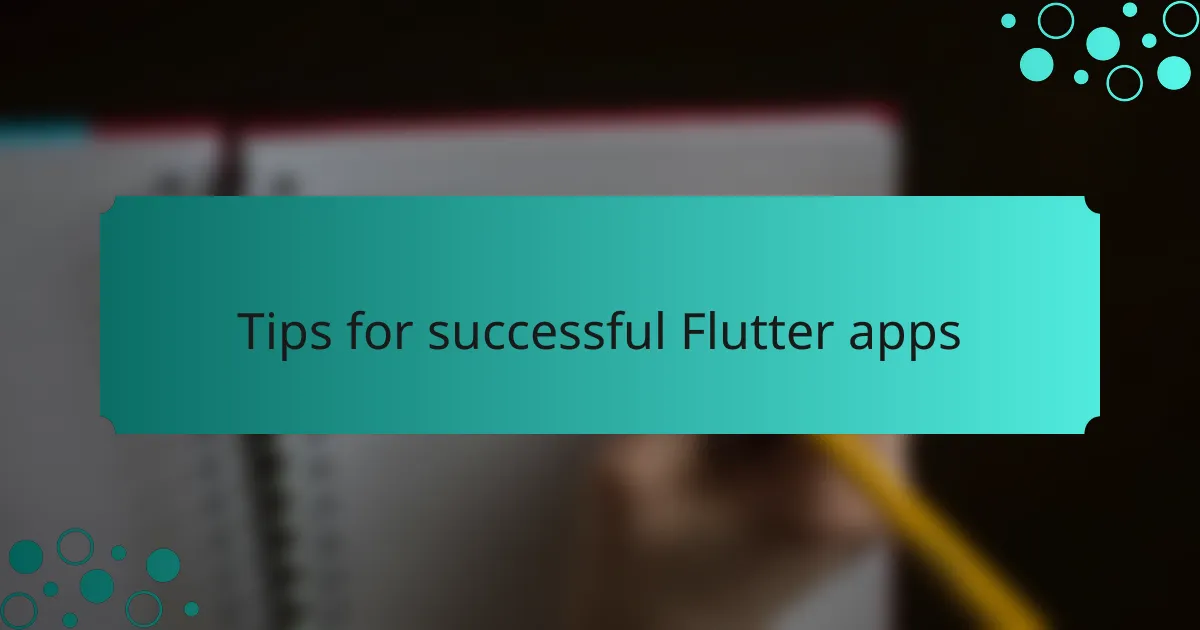
Tips for successful Flutter apps
When developing successful Flutter apps, I recommend prioritizing user experience. I remember the time I launched my first app and noticed that users were getting stuck at a specific point due to a confusing navigation structure. Making the interface intuitive not only enhances usability but also keeps users engaged. Have you ever wondered how a well-designed interface can impact user satisfaction? Trust me, it can make all the difference!
Another crucial tip is to leverage the community and available resources. I often found myself navigating hurdles that felt insurmountable, but a quick search on forums or Stack Overflow often provided the solution. The Flutter community is vibrant, and tapping into their collective knowledge can save you countless hours of frustration. It’s a reminder that you’re not alone on this journey—there are many others willing to share their insights.
Lastly, don’t shy away from thorough testing. I learned this the hard way after releasing an app that crashed intermittently on certain devices. Regular testing across different platforms and screen sizes ensures that your app performs well under various conditions. I still recall the anxiety of a bug report coming in right after launch; it really emphasizes the need for diligence in testing. Have you put your app through its paces before hitting that publish button? You’ll thank yourself later!
